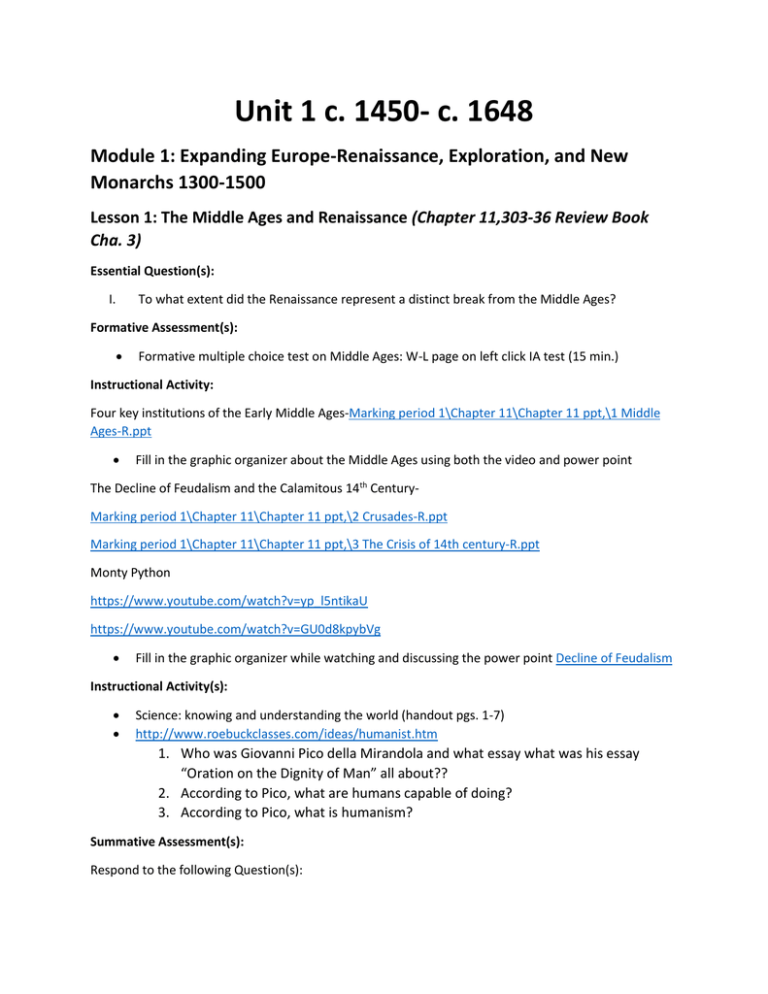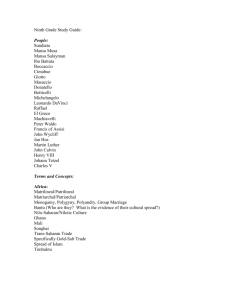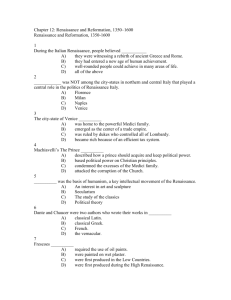Marking period 1\Chapter 14 New Encounters\powerpoints
advertisement

Unit 1 c. 1450- c. 1648 Module 1: Expanding Europe-Renaissance, Exploration, and New Monarchs 1300-1500 Lesson 1: The Middle Ages and Renaissance (Chapter 11,303-36 Review Book Cha. 3) Essential Question(s): I. To what extent did the Renaissance represent a distinct break from the Middle Ages? Formative Assessment(s): Formative multiple choice test on Middle Ages: W-L page on left click IA test (15 min.) Instructional Activity: Four key institutions of the Early Middle Ages-Marking period 1\Chapter 11\Chapter 11 ppt,\1 Middle Ages-R.ppt Fill in the graphic organizer about the Middle Ages using both the video and power point The Decline of Feudalism and the Calamitous 14th CenturyMarking period 1\Chapter 11\Chapter 11 ppt,\2 Crusades-R.ppt Marking period 1\Chapter 11\Chapter 11 ppt,\3 The Crisis of 14th century-R.ppt Monty Python https://www.youtube.com/watch?v=yp_l5ntikaU https://www.youtube.com/watch?v=GU0d8kpybVg Fill in the graphic organizer while watching and discussing the power point Decline of Feudalism Instructional Activity(s): Science: knowing and understanding the world (handout pgs. 1-7) http://www.roebuckclasses.com/ideas/humanist.htm 1. Who was Giovanni Pico della Mirandola and what essay what was his essay “Oration on the Dignity of Man” all about?? 2. According to Pico, what are humans capable of doing? 3. According to Pico, what is humanism? Summative Assessment(s): Respond to the following Question(s): 1. Analyze and support the statement “The chaos of the 14th century helped generate the new institutions of the 15th century” and the foundations of Early Modern Europe. Lesson 2: The Italian Renaissance (Chapter 11,326-34 Review Book Cha. 3) Essential Question(s): I. What were the beliefs and achievements of the Italian Renaissance humanists and artist during the early Renaissance? Formative Assessment(s): Answer one of the following prompts- a. Explain two reasons why the Renaissance took root first in Italy and one reason why it spread to the rest of Europe. b. List three Renaissance humanists, identify their most important contributions, and then define the term humanism. Marking period 1\Chapter 12 Renaissance\Powerpoints\renaissance people.ppt c. Draw an organizer that provides three or four of the key features of humanism along with appropriate illustrations. Instructional Activities: The Crusades and trade a) b) c) d) Using the Ancient Civilization textbook (430-435) answer the following questions related to trade. What regions and cultures were a part of Indian Ocean Trade? What were some of the items being traded? What sailing technologies were new to Europe? In general, which way did the trade flow? The Making of Renaissance Society - Chapter 12, pages 338-344 Fill in the spider diagram on social change in the Renaissance. The Medici Godfathers of the Renaissance (30 min.) http://www.pbs.org/empires/medici/resources/classroom.html Focusing Questions: As you watch, see how the Medici rose from poverty and insignificance. Also notice this: Why were art and architecture so important to the rise of the Medici? In what ways are accepted beliefs challenged? Zeitgeist: the defining spirit or mood of a particular period of history as shown by the ideas and beliefs of the time. Marking period 1\Chapter 11\stuff\Great_Chain_of_Being_2.jpg Creating a working description of Humanism- Chapter 12, 349-355 Review book 48-50 Working in groups of three that I will assign, students use three secondary sources (your textbook has to be one – page number, a second book, and something online) to craft your own description of humanism. Each group presents its work, and then, in class discussion, a final description of humanism is crafted. It is very important that you fully comprehend this final description of humanism. Not only will we use it again several times in this module it will be used throughout the year. Oration on the Dignity of Man by Giovanni Pico Della Mirandola ( text page 353) “....man's place in the universe is somewhere between the beasts and the angels, but, because of the divine image planted in him, there are no limits to what man can accomplish....” https://www.khanacademy.org/humanities/renaissance-reformation/high-ren-florencerome/high-renaissance1/v/raphael-school-of-athens Renaissance Values AP Euro 2015-16\Marking period 1\Chapter 12 Renaissance\Renaissance Values.doc Map and graphic organizer of Italian City States- Chapter 12, 344-348 Review book 48-49 Draw a freehand map of the Italian peninsula that labels the six major powers; Genoa, Milan, Venice, Florence, Rome and the Papal States, and Naples. Next, working together in small groups complete the graphic organizer about the city states and be prepared to compare/contrast them. http://vlib.iue.it/carrie/texts/carrie_books/gilbert/03.html Renaissance Artist- Chapter 12, 355-362 Review book 48-49 After each pair conducts research outside of class you will submit a one page report on your artist. You will present to the class and share information about where they were from/worked, patronage, subject matter, medium, best-known work, and connection to humanism. You will have a hard copy of that best- known work and share it with me via Google Docs. As students present, each student will take notes on the provided graphic organizer Instructional Activity(s): Science: knowing and understanding the world (handout pgs. 8-11) http://www.roebuckclasses.com/ideas/humanist.htm Summative Assessment(s): Respond to the following Question(s): 1. What was unique about Cosimo, Brunelleschi, and Florence? 2. How did Cosimo, Brunelleschi, and Florence contribute to the birth of the Renaissance? 3. What problems do you foresee for the Medici family? Why? 4. In what ways were the ancients and the great writers from the East and Orient different from the Christian thinkers of the Middle Ages? 5. In what ways does our society discourage or punish people for thinking, believing, and acting differently from the majority? Lesson 3: The Italian Renaissance Expands Essential Question(s): I. II. III. How did changes in art reflect the Renaissance ideals? How did the humanist writers challenge the status quo politically, intellectually, and socially? What were the features of Italian Renaissance humanism, and what impact did they have on European society, politics, ideas, and culture? How did the ideals of the Renaissance manifest themselves differently in Northern Europe as opposed to Italy? Lesson: The impact of the printing press https://www.youtube.com/watch?v=qexDBgWM2X8 Instructional Activities: The Italian States, Warfare in Italy, The Birth of Modern Diplomacy, Machiavelli and the New Statecraft The Renaissance Prince- AP Euro 2015-16\Marking period 1\Chapter 12 Renaissance\Powerpoints\renaissance people.ppt How did Machiavelli’s works reflect the political realities of Renaissance Italy? Using your textbook (pages 344-349) research and write a paragraph that answers the above question. In addition, choose a quote from Machiavelli (page 350) that would support your answer. Which Italian city-state would have been considered the most powerful by 1500? Be able to give evidence to support your response. Renaissance Artist- Presentations After each pair conducts research outside of class you will submit a one page report on your artist. You will present to the class and share information about where they were from/worked, patronage, subject matter, medium, best-known work, and connection to humanism. You will have a hard copy of that best- known work and share it with me via Google Docs. As students present, each student will take notes on the provided graphic organizer Art and Humanism- Northern Renaissance power point In a small groups, research three pieces of Renaissance art and any two artists (Not School of Athens). At least one work of art and one artist has to be from Northern Europe. Look for new artistic and cultural developments (e.g. portraits, perspective), the possible personal motivations of the artist, and any influence that humanism may have had on their chosen works. Lesson 4: The Northern Renaissance and The New Monarchies Essential Question(s): I. II. III. IV. How did changes in art reflect the Renaissance ideals? How did the humanist writers challenge the status quo politically, intellectually, and socially? What were the features of Italian Renaissance humanism, and what impact did they have on European society, politics, ideas, and culture? How did the ideals of the Renaissance manifest themselves differently in Northern Europe as opposed to Italy? Using England, France, and Spain, analyze the key features of these “new monarchies” and the factors responsible for their rise in the period 1450-1550. Formative Assessment(s): Short-Answer Questions https://en.wikipedia.org/wiki/The_Ambassadors_%28Holbein%29 Using the image of The Ambassadors by Hans Holbein, answer both of the following questions: a) Briefly explain the humanist ideals represented in the image and make judgments as to the effect of those ideals on the values held by Renaissance society. b) Briefly explain how these new humanist ideals contributed to the emergence of both a new theory of knowledge and a new conception of the universe. https://www.khanacademy.org/humanities/renaissance-reformation/northern/holbein/v/hans-holbeinthe-younger-the-ambassadors-1533 Instructional Activities: The Northern Renaissance (Ch. 12, 361-62- Rev. Book 49-51) Using the power point, textbook, and review book create a two circle Venn diagram labeling the left side Italian Renaissance characteristics and the right side Northern Renaissance Characteristics. The overlap area will be what the areas had in common. We will use this information in the next chapter for an essay about the Reformation. Van Eyck, The Arnolfini Portrait https://www.khanacademy.org/humanities/renaissance-reformation/northernrenaissance1/burgund Lesson 5: The New Monarchies (Ch. 12, 361-62- Rev. book 62-68) New Monarchies link: Marking period 1\Chapter 12 Renaissance\Powerpoints\8 EarlyMonarchies.ppt Using both the textbook and review book, complete SCAR (subject, Causes, Actions, Results) Louis XI of France, Henry VII of England, and Ferdinand and Isabel of Spain. We will then discuss reasons why strong monarchies did not develop in the Holy Roman Empire, Poland and Eastern Europe. In addition we will take a look at what was going on in the Ottoman Empire. In groups that I assign you will help narrate the power point on new monarchies. The Church in the Renaissance (pages 368-69) The Medici Godfathers of the Renaissance part 2 http://www.pbs.org/empires/medici/resources/classroom.html Formative Assessment(s): Party Planner-text 339 You have been hired by Lorenzo Medici to help plan a gathering of intellectuals and artists at his urban palace in Florence. In a group of three the task will be: assign seating at the dinner. A table of six needs to be arranged for three artist and three writers. In a short paragraph your group will need to explain their reasoning for placing the six individuals together. I will facilitate a short class discussion on who had the best seating chart and why. You will submit both seating chart and paragraph at the conclusion of the activity. Summative Assessment(s): Compare and Contrast the Middle Ages with The Renaissance-In a group of 5 fill in the graphic organizer (10 minutes) Write an essay that analyzes the influence of humanism on the visual arts in the Italian Renaissance. Use at least three specific works to support your analysis. (20 minutes) SAC- The Renaissance was a distinct break from the Middle Ages/ Support or refute. (10-12 minutes Lesson 6: Renaissance and exploration (Chap. 14, pages 410-432, RB 65-69) Essential Question(s): What was the impact of the European era of exploration and discovery on both Europe and the rest of the world? Chapter 14 New Encounters\Erostothenes.docx Instructional Activities: Students create a spider diagram titled “European Motives for Exploration and results”. The diagram will have 9 spokes radiating from the center circle and three branches radiating off of each spoke. In groups of 2-3 students will fill out SCAR organizer on the following topics: 1. Portugal pages 413-15 2. Spain pages 415-21 3. Slave trade pages 422-25 4. The West in Southeast Asia pages 425-26 5. The French and British in India pages 426-29 6. China and Japan pages 429-31 7. Americas pages 431-32 8. Impact on Conquered/Conquerors pages 433-38 9. World Economy/Mercantilism pages 438-40 Exploration PowerPoint: Marking period 1\Chapter 14 New Encounters\powerpoints\1 EuropeanExplorationAndColonization.ppt Slavery PowerPoint: Marking period 1\Chapter 14 New Encounters\powerpoints\AfricanSlavery.PPT Comercial Revolution PowerPoint: Marking period 1\Chapter 14 New Encounters\powerpoints\Columbian Exchange and Commercial Revolution.ppt https://www.khanacademy.org/humanities/renaissance-reformation/early-renaissance1/beginnersrenaissance-florence/v/linear-perspective-brunelleschi-sexperiement?utm_source=Sailthru&utm_medium=email&utm_term=Stuff%20you%20might%20like%20 After%20Test%20Cohort%20Made&utm_campaign=Highlighted%20Content%20110923%20[Final]%20%202nd%20list In small groups, students will explain the rise and impact of slave trade. They then share with the class. Summative Assessment(s): SAC- Columbian Exchange: Did the advantages outweigh the disadvantages? Why were the nations of the Iberian Peninsula the first to sail and explore the Atlantic? Analyze the various effects (3) of the expansion of the Atlantic slave trade on the economy of Western Europe in the period circa 1450-1700. Identify and analyze ONE significant impact that exploration had on Europe and ONE significant impact it had on the Americas. Chapter 11-14 PowerPoint review questions with answers: Marking period 1\Chapter 14 New Encounters\powerpoints\11 Review Chapter 11 with Explanations.ppt Chapter 14 I-TestMarking period 1\Chapter 14 New Encounters\ch 14 apeuro.pdf Lesson 7: Reformation (Chap. 13, pages 373-383, RB 53-56) Chapters 13-14 I-Test Marking period 1\Chapter 13 Reformation\APEURO_Exploration -Reformation ans..pdf You need to read this and the questions at the end: http://www.roebuckclasses.com/ideas/reformation.htm https://en.wikipedia.org/wiki/Ship_of_fools Homework: spider diagram titled causes of the Protestant Reformation Essential Question(s): I. II. III. IV. V. What were the essential ideas of the reformers, and why were their ideas appealing to different social groups? How did the reformers convey their message to their followers? How did the state of political affairs in Germany and England shape the course of the reformations in their respective countries? How did the Catholic Church respond to the new religious status quo? What were the causes and consequences of the religious violence that followed the Protestant Reformation? Instructional Activities: Viewing projected images of Piero della-Franceca’s Flagellation and Grunewald’s Crucifixion, students compare the paintings in terms of subject matter, style, and goal of the artist. Be able to discuss the different preoccupations of the Northern Renaissance as opposed to the Italian Renaissance. http://www.ibiblio.org/wm/paint/auth/piero/flagellation.jpg https://en.wikipedia.org/wiki/Isenheim_Altarpiece#/media/File:Chapel_of_Unterlinden _Museum_with_Isenheim_altarpiece.jpg In small groups, students research the Catholic Church during the Renaissance and list in numeric order the issues surrounding the church (review book pages 53-54). What were the chief ideas of the Christian Humanist? How will they differ from the ideas of the Protestant Reformers? “Erasmus laid the egg that Luther hatched”- explain this. Erasmus page 374, Thomas More 375-76, Opposing viewpoints page 350 with questions. Julius Excluded from Heaven https://en.wikipedia.org/wiki/Julius_Excluded_from_Heaven 1. 2. 3. 4. 5. 6. 7. 8. 9. Students will watch clips from the movie Luther and take notes on the following topics: What were Luther’s views about sin and salvation? What happened when Luther visited Rome? What was the university classroom like? Was Tetzel a good salesman? (Text page 379, Luther’s 95 Thesis) How and why did Luther’s word get around so quickly (2 reasons)? What happens at the meeting with Frederick the Wise and Charles the V? What happened at Worms in 1521 and why was that a no turning back moment? Who kidnaps Luther and what does he do during that time? Peasant’s revolt, Professor Andreas Carlstadt, and Luther’s response. Instructional Activity: Collaborative Lecture on Reformers- Students research one of the following prior to class: John Wycliffe, Jan Hus, William Tyndale, Martin Luther, Ulrich Zwingli, John Calvin, the Anabaptist, or Henry VIII. In class I will facilitate a discussion via PowerPoint presentation, and students will contribute to the discussion by answering questions and by adding information as their assigned individual or group is presented. Marking period 1\Chapter 13 Reformation\power points\ProtReformation-R.ppt Instructional Activity: Students read the 2008 DBQ documents from about the German’s Peasant War and complete a SPRITE chart based on the documents and their textbook readings Students will independently write an introduction and thesis statement responding to the DBQ question In a group research one of the following social groups (in the context of the 16th century and the Reformation): peasants, bourgeoisie, nobility, women, youth, or the poor (392-95). How did the Reformation effect: social classes, gender family, and religious practices? Were there any traditional norms unaffected? Lesson 8: Europe and the Reformation: Religion and Politics Instructional Activity: Using the map and readings from the textbook, students identify the impact of the Reformation on regions of Europe Collaborative Lecture on European wide impact of the Reformation- Students research one of the following prior to class, each person will have a SCAR Graphic Organizer and a Spider Diagram: o Holy Roman Empire and Charles V (text pages 383-85) o England and Henry VIII (text page 389-91RB 57-58) o France (text pages 399-400) o Phillip II and Spain (text 401-02) o The Netherlands (text 403) o Elizabeth I and England (text 403-06 RB 57-58) Using the map and readings from the textbook, students identify the difficulties that Charles V faced during his reign. Dracula vid clip Instructional Activity: Charles V & Mary Tudor https://www.youtube.com/watch?v=q8sA_tn_8UA A Man for All Seasons https://www.youtube.com/watch?v=DX0_FGu8v9A The Catholic Reformation (pages 395-99, review book 59-60) In selected groups students will research and present information on the following topics: Council of Trent, the Jesuits and new religious orders, the Inquisition and the Index of Prohibited Works, and the Baroque and Mannerist Art Movements. In small groups, students research and outline a response to the 2006 exam question, Analyze the aims, methods, and degree of success of the Catholic Reformation (CounterReformation). Formative Assessment: In a continuation of the previous activities, students will now write response to the 2006 exam question



